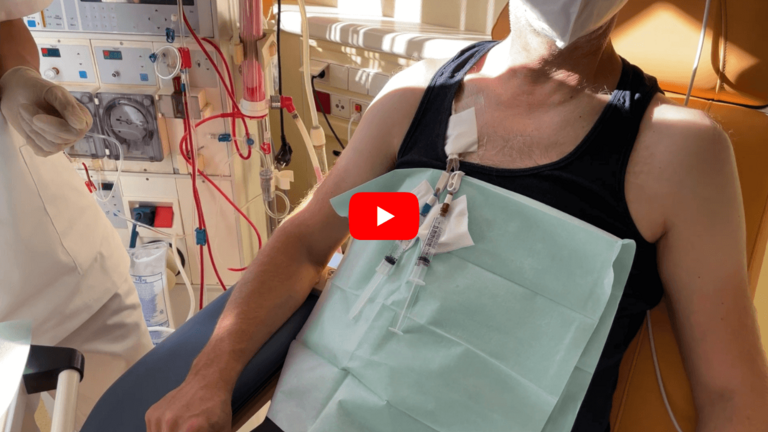Port care: A guide
for patients and nurses
A small access point under the skin, barely visible, barely noticeable – and yet vital for survival. The port catheter is an indispensable part of modern medicine. It simplifies lengthy treatments, provides protection against repeated venipunctures and enables outpatient care in cases of serious illness. It has proven to be a valuable alternative, especially for patients with poor peripheral veins.
But all of this only holds true with professional handling and the highest standards of hygiene. Port care is the decisive factor for whether (and how long) it will stay functional. A complex interplay of preventive measures, careful observation and individual adjustments – always with the aim of avoiding complications (and particularly infections).
This article speaks to both staff and patients. It explains how and where ports come into play, how to deal with them and how to minimise risks. The access point may be under the skin – but safe management begins long before that.
Übersicht
- A port-a-cath (“port” in short) is a totally implantable venous access device. The system consists of a port chamber (made of titanium or plastic, with a silicone membrane/septum) and a catheter (usually silicone or polyurethane) that extends to the heart.
- The port is implanted under the skin – usually in the chest area, occasionally also on the arm.
- A Huber needle is used to puncture the membrane. This keeps the membrane intact and the access functional.
- The access point can be punctured around 1,500 to 2,000 times and remain in place for years (with the appropriate port care).
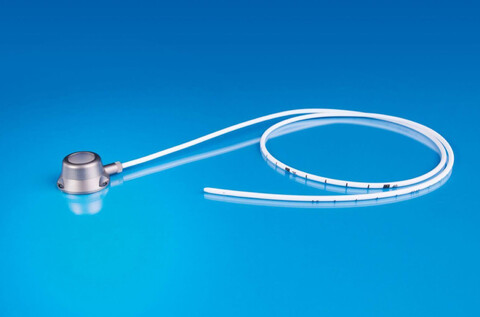
Port catheters always become necessary when reliable venous access is required over a longer period of time. Common areas of application include:
Oncology
Many forms of cancer must be treated with months of chemotherapy, during which the drugs can severely irritate the veins. Ports make it possible to administer chemotherapy more gently and with fewer risks.
Parenteral nutrition
In cases of chronic diseases of the gastrointestinal tract (e.g. short bowel syndrome, Crohn's disease, or tumours), nutrients must be administered intravenously. Ports are one available option, alongside Hickman catheters or PICCs (peripherally inserted central catheters).
Chronic infections or immune deficiencies
Long-term antibiotic therapies (e.g. osteomyelitis or cystic fibrosis) as well as HIV or other immunocompromising diseases require frequent infusions. PICCs are usually used for this purpose, but ports can also serve as an alternative.
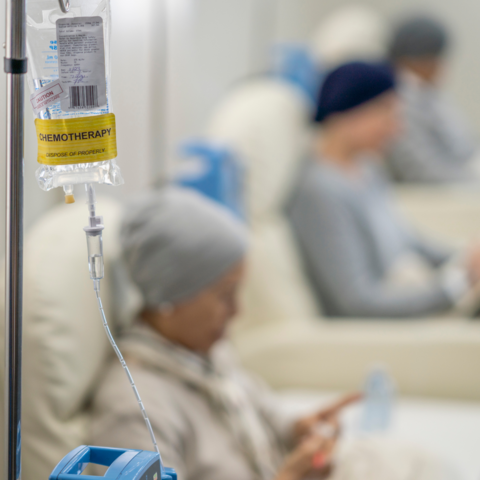
Palliative care
For terminally ill people, a port can be used to continuously administer painkillers or sedatives. This means that patients do not have to undergo repeated peripheral punctures, which would further impair their quality of life.
Transfusion programmes
In cases of chronic anaemia or diseases that require regular blood transfusions (e.g. thalassaemia, sickle cell anaemia, or myelodysplastic syndrome (MDS)), a port provides the venous access.
Autoimmune diseases / rheumatology
In severe forms of diseases such as lupus erythematosus or rheumatoid arthritis, highly effective drugs (e.g. biologics) can be administered intravenously on a regular basis via ports.
As a permanent alternative to venous access in the arm, ports offer considerable relief. Repeated punctures are not only painful and unreliable, but simply impossible over a longer period of time.
- For patients, this means less pain and more mobility. Activities such as showering, going to the sauna, or light exercise are easier (with the right port care). Another plus in everyday life: the access remains cosmetically inconspicuous, hidden under the skin.
- For medical professionals, it means less work. On one hand, patients do not need new access points inserted all the time. On the other hand, catheter complications are less common.
As a general rule, central-venous access devices should exclusively be managed by trained personnel. Patients and their relatives can help by following hygiene regulations and reporting any unusual symptoms at an early stage.
Preparation and puncturing
- Everything that comes into contact with the port must remain sterile. Make sure to always disinfect your hands and work surfaces, and wear gloves and a face mask.
- Port care requires the following materials: sterile compresses, adhesive tape or plasters, saline solution (NaCl 0.9 %) for rinsing, lock solution for blocking, gloves and face mask, sterile pad, waste container, three-way stopcock.
- To puncture, aim vertically (90 degrees) and as centrally as possible on the septum. Select the needle length according to the skin-fat distance (e.g. 19–38 mm). It is important that you hold the port securely between two fingers.
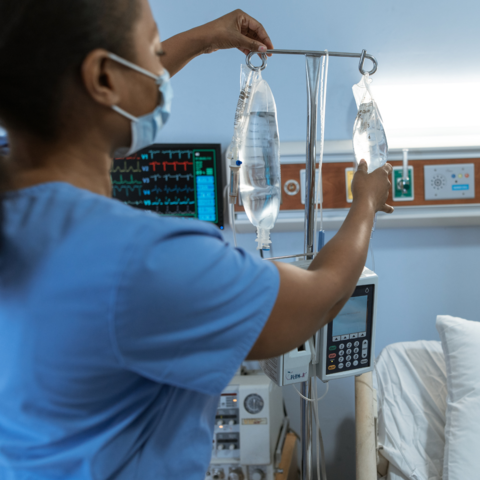
Handling port needles and dressings
- Use port needles with a special Huber bevel and be careful not to damage the silicone membrane.
- Regular changes of the needles, usually every 7 to 14 days, are part of the catheter care routine. If you notice signs of contamination or inflammation, replace the needle immediately.
- The port is secured with a bandage, ideally with transparent plaster for observation. The bandage should be changed approximately every seven days (or as needed, if it becomes dirty, for example).
- Before removing a needle, flush and lock the port.
Flushing the port
After each use, the port must be flushed with a saline solution (NaCl 0.9 %, at least 10 ml, preferably 20 ml after blood sampling). Official guidelines [1] recommend the pulsatile flushing technique (also known as the push-pause technique): Intermittent flushing with 10 bolus doses of 1 ml each and a time interval of 0.4 seconds between two bolus doses. This method removes deposits (e.g. fibrin, drug residues, intraluminal bacteria) more effectively than continuous low-flow techniques.
If you care for a port that has not been in use for a long time, you should flush it at least every four weeks (ideally more often). Intervals may vary, depending on the patient or facility.
Locking the port
Flushing with saline does not suffice to shield the port against complications. To effectively prevent occlusion, thrombosis, and infection, you also need a lock solution. The TauroLock™ range offers a number of product variants for this purpose. The basis for each product is taurolidine – an antimicrobial agent with broad efficacy against more than 500 bacteria and fungi. Unlike antibiotics, taurolidine does not have the side effect of pathogens becoming resistant over time. TauroLock™ solutions contain additional active ingredients to ensure adequate protection for patients in different areas of application. Each of these products is designed for central-venous catheter and port care. Which variant is the best option for a patient depends on individual needs.
| Product | Ingredients | Recommended Fields of Application |
|---|---|---|
 |
|
|
 |
|
|
 |
|
|
 |
|
|
 |
|
|
Numerous studies have confirmed the efficacy of taurolidine in preventing catheter-related complications, including in parenteral nutrition and oncology. [2-5]
National and international expert committees also recommend taurolidine-based lock solutions. [1,6,7,8]
In some institutions, locking with TauroLock™ products has already become standard practice – for example, at the port centre of Heidelberg University Hospital. [9]
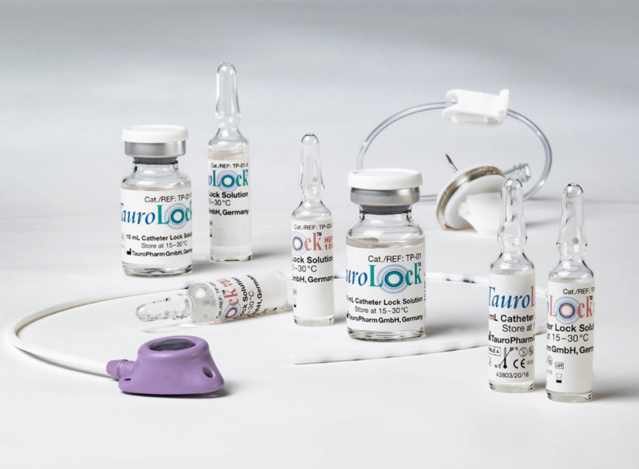
Why is catheter management so important?
Any invasive access carries potential risks, both immediately after the implantation and in the long term. Professionals and patients need to be aware of these risks – because the more you know about them, the faster you can recognise warning signs and take appropriate measures. Here, you can find an overview of possible complications – and what to do about them.
Infections
- Port infections can occur at the insertion site or along the catheter. Catheter-related bloodstream infections (CRBSI) are particularly dangerous. In the worst case, such an infection can lead to sepsis.
- Symptoms: redness, swelling, overheating, pain, fever, or purulent secretion.
- Measures: Preventive locking with an antimicrobial lock solution and regular flushing with saline.
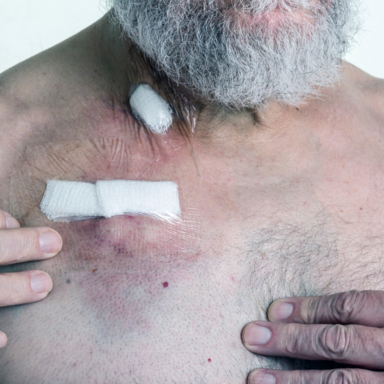
Thrombosis
- The catheter can cause a clot, usually in the subclavian vein (central-venous thrombosis).
- Symptoms: Swelling of the arm, feeling of pressure, bluish discolouration, feeling of tension.
- Measures: Preventive locking with an antimicrobial lock solution. If thrombosis has already developed, TauroLock™-U25.000 can be used for treatment. This lock solution contains urokinase (a thrombolytic agent) as an additional active ingredient.
Catheter occlusion
- Occlusion occurs when the catheter or port is blocked by deposits.
- Symptoms: Restricted or no flow, increased resistance during flushing, possibly pain.
- Measures: Preventive locking with an antimicrobial lock solution that also contains an anti-occlusive active ingredient (citrate in low concentrations and/or heparin). Deblocking with TauroLock™-U25.000. Regular flushing with saline.
Pneumothorax oder haematoma (rare)
- During port implantation (especially with subclavian access), air may enter the pleural space (pneumothorax) or a haematoma may develop.
- Symptoms: shortness of breath, chest pain, circulatory problems.
- Measures: In severe cases, drainage may be necessary.
Allergic reactions or intolerances
- Some patients may be intolerant to port materials (e.g. silicone, contrast medium during implantation).
- Symptoms: Skin reactions, itching, inflammation, foreign body sensation.
- Measures: If feasible, switch to other materials or administer medication to alleviate the symptoms.
A permanently implanted catheter makes life easier in many ways: No constant needle pricks, no irritating access on the skin. But in order to fulfil its practical function, a port must be managed carefully. Patients should pay particular attention to the following:
- Check daily if the needle is correctly positioned and sufficiently secure.
- Watch out for symptoms that could indicate an infection (redness, swelling, pain, discharge). If you experience increasing pain, fever, or leakage, contact the responsible nursing staff immediately.
- Avoid frequent manipulation – any contact increases the risk of infection.
- During the puncture, try to remain as calm as possible and turn your head away from the puncture site so that you do not breathe into the port area.
- You can protect dressings with inserted needles when showering by using water-resistant plasters. There are also waterproof plasters which (after consulting your doctor) even allow you to bathe.
If you adhere to all recommendations for port care and there are no complications, the implant can remain under the skin for years. Many oncologists advise that cancer patients leave the implant in their body for about two to three years after chemotherapy has ended. This way, the catheter might be used again if further treatment becomes necessary. The port is usually removed at an outpatient facility under local anaesthetic. Eventually, only a small scar remains.

- Nickel et al. J Infus Nurs 2024. DOI: 10.1097/NAN.0000000000000532
- Simon et al. BMC Infect Dis 2008. DOI: 10.1186/1471-2334-8-102
- Handrup et al. Pediatr Blood Cancer 2013 DOI: 10.1002/pbc.24482
- Tribler et al. Am J Clin Nutr 2017. DOI: 10.3945/ajcn.117.158964
- Nerstrøm et al. Clin Nutr 2025. DOI: 10.1016/j.clnu.2025.05.020
- Simon et al. Society for Paediatric Oncology and Haematology (GPOH) 2018. Print.
- Cuerda et al. Clin Nutr 2021. DOI: 10.1016/j.clnu.2021.07.002
- Pittiruti et al. Italian Association for Venous Access (GAVeCeLT) 2024.
- Hennes et al. Ports. Standards of Care – Implantation Techniques – Port Care. Springer-Verlag Berlin 2016. DOI: 10.1007/978-3-662-43641-7



